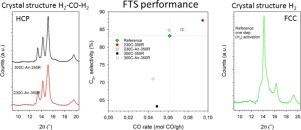Applied Catalysis A: General ( IF 4.7 ) Pub Date : 2017-10-12 , DOI: 10.1016/j.apcata.2017.10.007 Eleni Patanou , Nikolaos E. Tsakoumis , Rune Myrstad , Edd A. Blekkan

|
Different activation protocols were applied to a promoted Re/Co/γ-Al2O3 catalyst for Fischer-Tropsch synthesis. The activation included treatment in either pure H2 or a sequence of Reduction (H2) – Carburization (CO) – Reduction (H2) in order to vary the microstructure of Co nanoparticles and investigate their performance. The alternative activation protocol applied under specific conditions (carburization at 230 °C and final reduction at 350 °C) outperform the conventional activation both in terms of catalyst activity and C5+ selectivity. The catalyst was characterized in all the stages of the activation process by synchrotron based X-ray diffraction (XRD) and X-ray absorption near edge structure spectroscopy (XANES). The effect of air exposure at room temperature of the carburized sample was investigated and it was found that air exposure leads to minor phase changes that significantly affect catalyst performance. Carburization temperature and temperature used for the decomposition of the carbide on the final reduction step both had a severe effect on catalyst performance, but neither of them influenced considerably the microstructure of Co nanoparticles that was primarily hexagonal (hcp). All carburized samples contained a significant amount of carbon as observed by Thermogravimetric analysis (TGA) and Raman spectroscopy. The final reduction step could remove part of the excess carbon produced during CO disproportionation. It appears that the carbon removal\minimization is a key factor for the exploitation of the benefits of hcp configuration of Co nanoparticles catalysing Fischer-Tropsch synthesis.
中文翻译:

连续H 2 -CO-H 2活化处理对费托合成钴基催化剂结构和性能的影响
不同的激活协议被应用到促进的重新/ CO /γ-Al系2 ö 3为费-托合成催化剂。活化包括纯H 2或还原(H 2)–渗碳(CO)–还原(H 2)的处理,以改变Co纳米颗粒的微观结构并研究其性能。在特定条件下(230°C的碳化和350°C的最终还原)应用的替代活化方案在催化剂活性和C 5+方面均优于常规活化选择性。催化剂在活化过程的所有阶段都通过基于同步加速器的X射线衍射(XRD)和X射线吸收近边缘结构光谱(XANES)进行了表征。研究了渗碳样品在室温下暴露于空气的影响,发现暴露于空气会导致微小的相变,从而显着影响催化剂的性能。渗碳温度和最终还原步骤中碳化物分解所使用的温度均对催化剂性能有严重影响,但它们均未显着影响主要为六角形(hcp)的Co纳米颗粒的微观结构。通过热重分析(TGA)和拉曼光谱法观察到,所有渗碳样品均含有大量碳。最后的还原步骤可以去除在CO歧化过程中产生的过量碳的一部分。看来,碳的去除/最小化是利用Co纳米颗粒的hcp构型催化费-托合成的好处的关键因素。











































 京公网安备 11010802027423号
京公网安备 11010802027423号